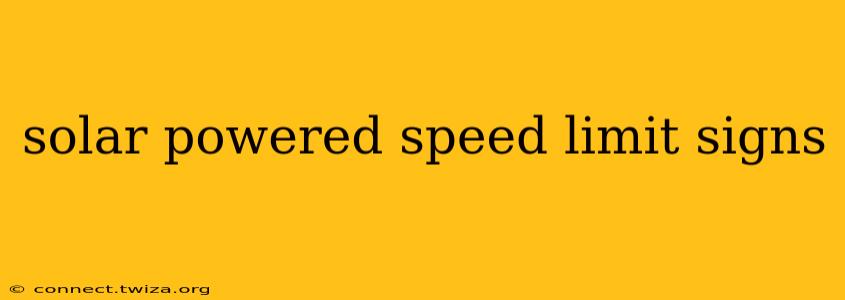Solar-powered speed limit signs represent a significant advancement in traffic management technology, offering a sustainable and cost-effective solution for municipalities and transportation authorities. These signs utilize solar energy to power their internal components, eliminating the need for costly and environmentally unfriendly grid electricity. This guide will delve into the specifics of these innovative signs, addressing frequently asked questions and exploring their benefits and limitations.
What are the benefits of solar-powered speed limit signs?
Solar-powered speed limit signs offer a multitude of advantages over their traditional counterparts. Primarily, they contribute to environmental sustainability by reducing reliance on fossil fuels. Beyond this crucial aspect, they boast significant cost savings in the long run, eliminating electricity bills and reducing maintenance needs associated with traditional power sources. Furthermore, their ease of installation and remote placement make them ideal for various locations, even those without readily accessible power grids. Finally, their self-sufficiency means fewer disruptions caused by power outages, ensuring consistent functionality and improved road safety.
How much do solar speed limit signs cost?
The cost of solar-powered speed limit signs varies depending on several factors, including the size, features (e.g., radar capabilities, LED brightness), and the manufacturer. Generally, the initial investment is higher than traditional signs, but the long-term savings from reduced energy consumption and maintenance easily offset this initial expense. It's crucial to obtain quotes from several reputable suppliers to compare pricing and features before making a purchase. Consider factors like warranty periods and potential maintenance contracts when evaluating the overall cost.
How long do solar speed limit signs last?
The lifespan of a solar-powered speed limit sign depends heavily on the quality of its components and the environmental conditions it's subjected to. High-quality signs, constructed with durable materials and incorporating advanced solar technology, can last for 10-15 years or even longer. However, regular maintenance, including cleaning the solar panels and checking the battery system, is crucial for extending their lifespan. Harsh weather conditions, such as extreme temperatures and heavy snow, can potentially shorten their operational life, so factors like sign location play a crucial role.
Are solar speed limit signs effective?
The effectiveness of solar-powered speed limit signs is largely dependent on their visibility, placement, and the overall traffic management strategy in place. When properly placed and maintained, these signs significantly contribute to improved road safety by reminding drivers of speed limits. While they don't actively enforce speed limits, their consistent visibility can encourage drivers to adhere to regulations, ultimately reducing the risk of accidents. Integrating them with other traffic calming measures, such as speed bumps or cameras, can amplify their effectiveness.
How are solar speed limit signs powered?
These signs utilize photovoltaic (PV) solar panels to convert sunlight into electricity. This electricity charges a battery pack within the sign, which then powers the LED display and other internal components. The size and capacity of the battery pack determine the sign's operational time during periods of low sunlight. Advanced models may incorporate features like energy-efficient LED lighting and smart power management systems to optimize energy consumption and extend battery life.
What are the disadvantages of solar speed limit signs?
While offering numerous advantages, solar-powered speed limit signs also have some limitations. Their effectiveness is reliant on sufficient sunlight; in locations with limited sunlight, such as areas with frequent cloud cover or long periods of darkness, their performance can be compromised. The initial investment cost can be higher than traditional signs, though long-term savings generally outweigh this. Furthermore, the need for periodic maintenance, such as cleaning solar panels and checking the battery, should be factored into the overall operational costs.
Where can I buy solar speed limit signs?
Solar-powered speed limit signs are available from various suppliers, including specialized traffic equipment manufacturers and distributors. It is essential to thoroughly research different suppliers, comparing their product offerings, prices, warranties, and customer reviews before making a purchase. Consider contacting local transportation agencies or municipalities; they may be able to provide recommendations based on their own experiences and procurement processes.
This comprehensive guide provides a detailed overview of solar-powered speed limit signs, addressing several key considerations for those interested in adopting this sustainable and cost-effective traffic management solution. Remember to always conduct thorough research and choose reputable suppliers to ensure the longevity and effectiveness of your investment.
